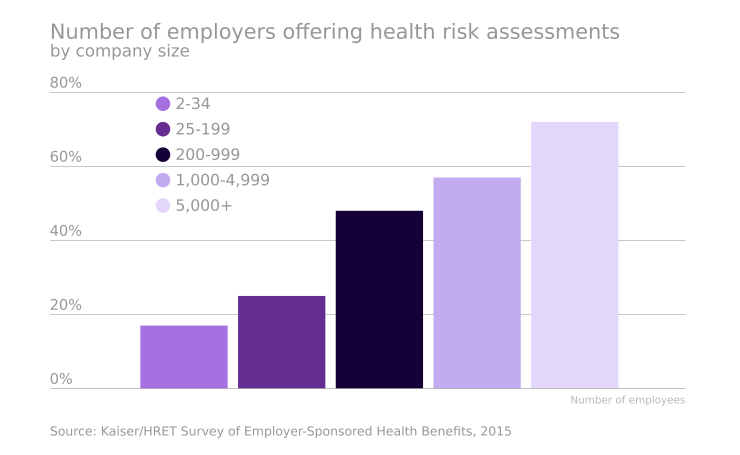The United States District Court in the Western District of Wisconsin recently released a decision in EEOC v. Flambeau, Inc., determining that the company did not violate the Americans with Disabilities Act by requiring employees to complete a health risk assessment and biometric screening test in order to be eligible for the company’s self-funded group health plan.

However, because the Equal Employment Opportunity Commission is expected to appeal the decision and has released draft regulations to nix gateway HRAs, Judge Barbara Crabb’s pro-employer ruling is far from the last word on this important issue.
In 2011 Flambeau established a wellness program that included an HRA and biometric screening. Employees who voluntarily participated got a $600 credit. By 2012 and 2013, the company got rid of the $600 credit and instead began offering health insurance only to those employees who filled out the questionnaire about their medical history, diet, mental health and job satisfaction and offered blood samples.
Flambeau employee Dale Arnold participated in the program in 2011 and got a $600 credit. In 2012 he missed the deadline and the company discontinued his health insurance coverage. As a result, he filed a union grievance and complaints with the Department of Labor and the EEOC. Although Arnold’s claim was settled when he took the tests and was reinstated in the plan, the EEOC sued Flambeau alleging that it violated the ADA provisions that generally prohibit employers from requiring their employees to submit to medical examinations.
Paul Hamburger, a partner in the employee benefits practice at Proskauer in Washington D.C., believes that the EEOC continued the lawsuit because Flambeau’s testing program was in direct violation of an EEOC informal discussion letter written by the Commission’s associate legal counsel Peggy Mastroianni in 2009. “Until the draft guidelines were issued, the EEOC historically regulated by rumor gossip and innuendo. Their approach was, ‘you figure it out and we’ll sue you if you are wrong,’” he says.
He also believes the EEOC was looking for a ‘win’ that would nullify the impact of the previous Seff decision in Florida where an appeal court held that the district court did not err in finding as a matter of law that the wellness program was a ‘term’ of Broward County's group health insurance plan, so the wellness program fell within the ADA's safe harbor provision.
Decision
However, on a motion for summary judgment in the Flambeau case, the Judge accepted the argument made by Flambeau’s counsel that in this case the assessment and testing requirement fell within the ADA’s “safe harbor” which provides an exception for activities related to the administration of a bona fide insurance benefit plan.
Judge Crabb noted, “The company used this information to estimate the cost of providing insurance, set participant’s premiums, evaluate the need for stop-loss insurance, adjust co-pays for preventative exams and adjust the co-pays for certain prescription drugs.”
Employers spend a ton of money on wellness, yet many programs fail to engage employees over the long term. Emily Noll, national director of wellness with CBIZ Benefits and Insurance Services, Inc. shares 10 reasons employees dont like wellness programs.
The Judge also rejected the EEOC’s argument that their proposed rules specifically provide that the ADA’s “safe harbor” provision applicable to insurance as interpreted by the court in the Seth case is not the proper basis for finding wellness program incentives permissible.
In her ruling, she wrote that proposed regulations are not entitled to deference. Furthermore, she noted that in any event, the EEOC’s proposed regulation speaks only to the safe harbor’s application to “wellness program incentives.” “It says nothing about the safe harbor’s applicability to medical examinations that are part of a wellness program and are used to administer and underwrite insurance risks associated with an employer’s health plan,” she said.
A different perspective
While employers are applauding the Flambeau decision, Al Lewis, founder and president of the Disease Management Purchasing Consortium International, Inc. gives it a “thumbs down.” In his blog They Said What?, Lewis (who calls himself “Trouble-Maker-In-Chief”) says Flambeau created a program so onerous that some number of employees would prefer to forego insurance altogether than participate in wellness. “This decision means they’re getting away with it, saving thousands of dollars apiece for each employee who refused to submit,” he says.
I’ve never come across a client that called me and said, ‘hey Joe, tell us how we can keep people out of the plan to save premium dollars.’
But Joseph Lazzarotti, a principal in the Morristown, New Jersey office of Jackson Lewis thinks Lewis has it all wrong. “I’ve worked for a few hundred clients over the years who have wellness programs, and I’ve got to tell you, I’ve never come across a client that called me and said, ‘hey Joe, tell us how we can keep people out of the plan to save premium dollars.’ That’s not the goal,” he says.
Nevertheless, Lazzarotti understands why employees may be wary of HRAs and biometric testing. “There is always a concern about privacy, about analytics, about big brother,” he says. “In fact the data is captured by a third party that produces aggregate reports with individual employee identification removed for the purposes of recommending targeted communication or education – for example if a significant number of employees are diabetics, smokers or obese.”
What’s next?
So how are lawyers advising their clients about wellness plan designs?
“Even before this decision was released and the EEOC draft rules were issued we advised clients that if they choose to make an HRA and biometric testing a pre-requisite to health plan participation they need to be mindful of the business risks they will incur because they are taking action that is directly contrary to the views of the EEOC,” Hamburger says. “And if gateway HRAs are clearly prohibited in final EEOC regulations, I doubt that any lawyer would advise a client to do it anyway.”
Depending on the final wording of the EEOC regulations, a company might try to argue that the safe harbor exception cannot be read out of the statute via regulation because that’s a job for Congress.
But Hamburger suggests that once the final EEOC rules are issued if a company is sued for having a plan design that discriminates under the ADA, the only successful defense may be that the regulatory body has exceeded its jurisdiction because it did not have the authority to issue the regulations in the first place.
“Depending on the final wording of the EEOC regulations, a company might try to argue that the safe harbor exception cannot be read out of the statute via regulation because that’s a job for Congress,” he says.






